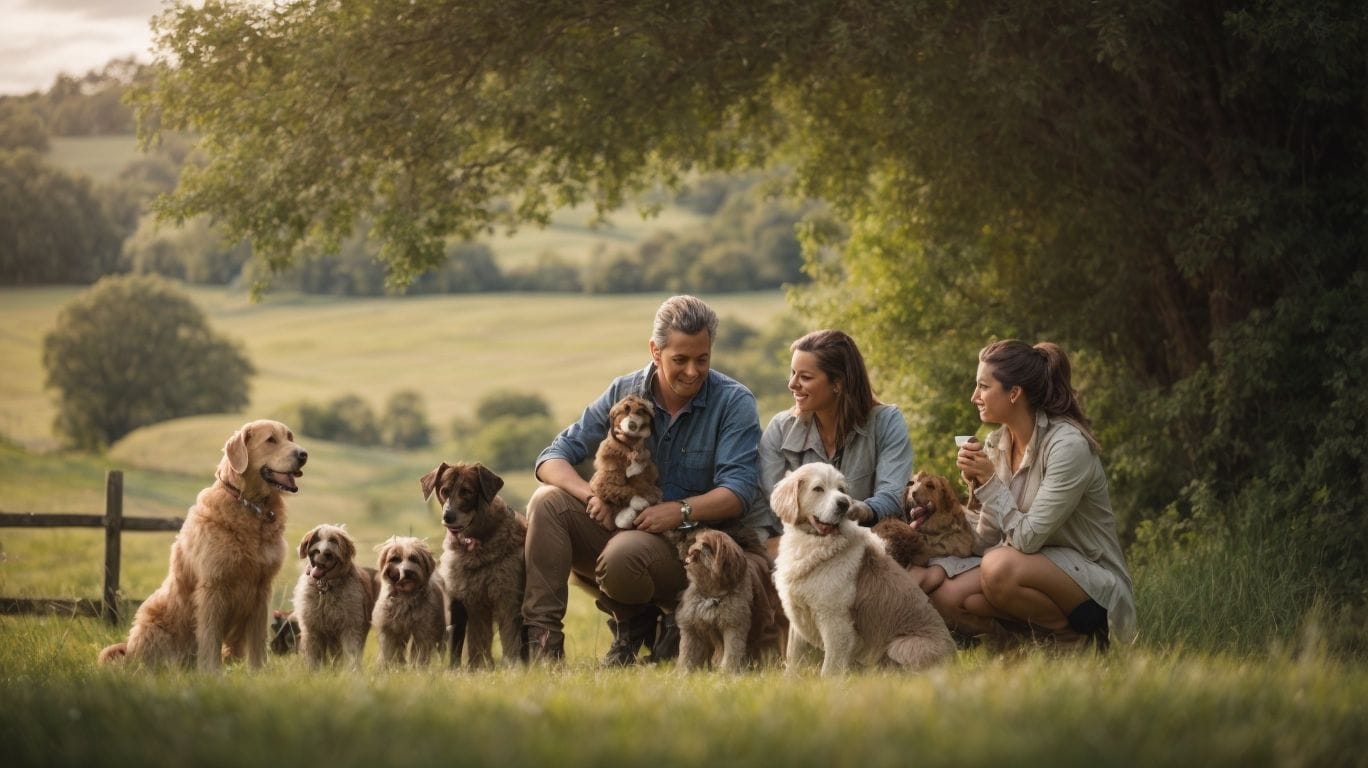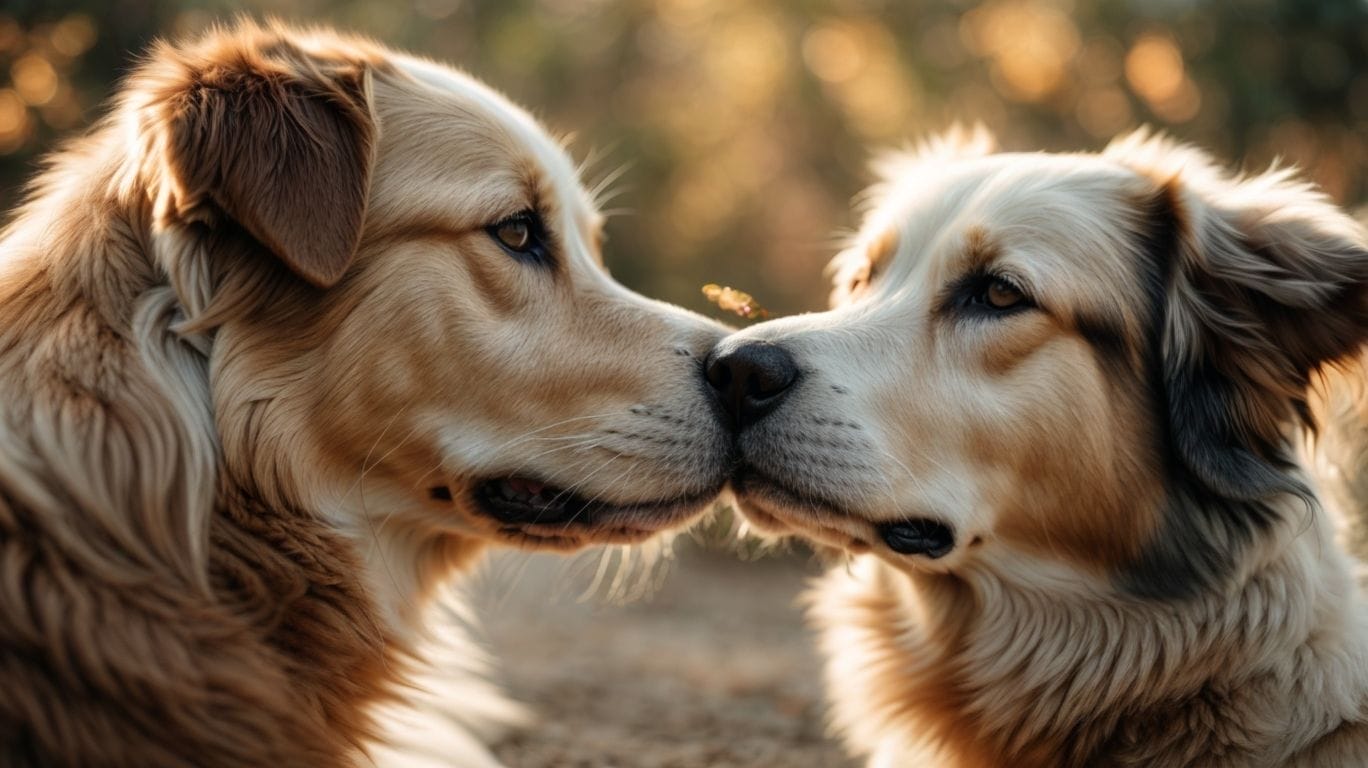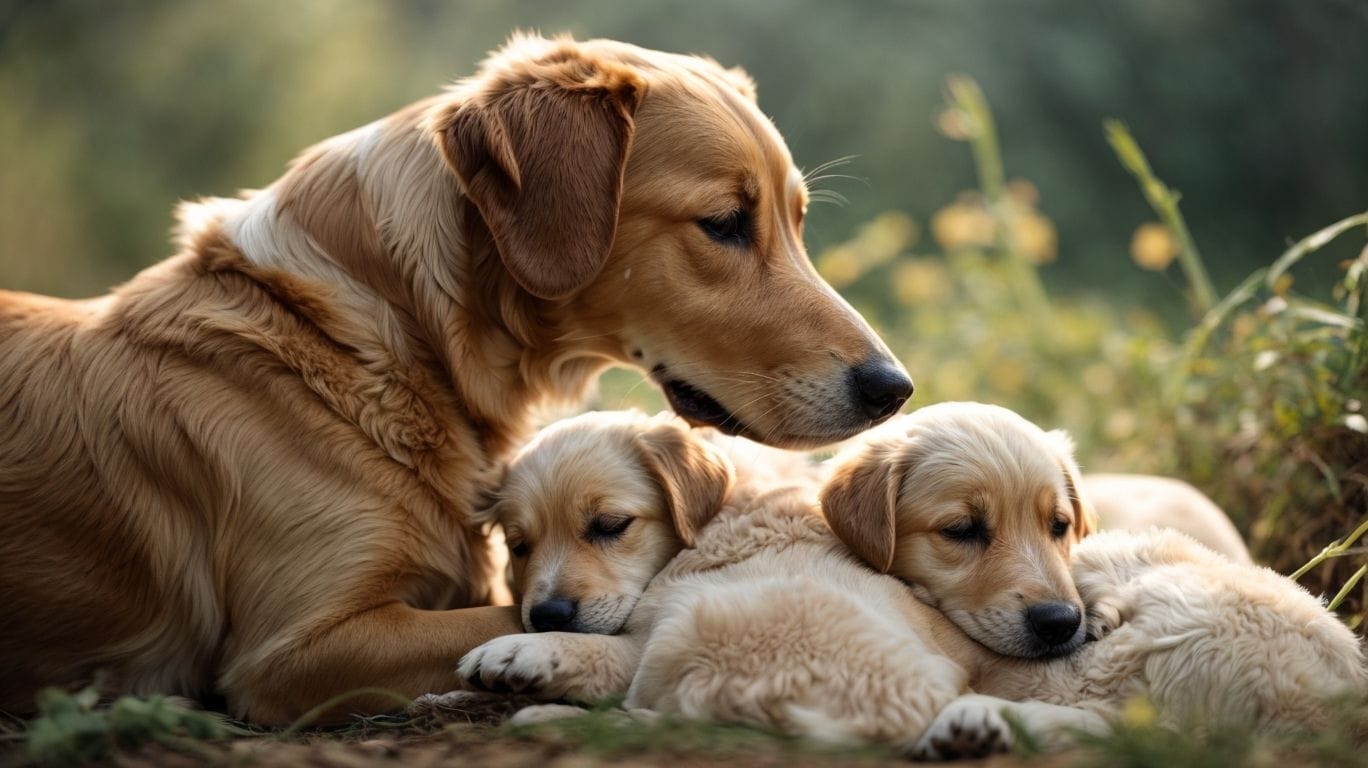Breeding dogs is a complex process that requires careful consideration and responsibility.
Before deciding to breed dogs, several factors need to be taken into account.
Health and genetic testing are crucial to ensure the parent dogs are free from hereditary diseases or genetic conditions that could be passed down to their offspring.
Age and reproductive readiness of both the male and female dogs should also be considered to ensure successful reproduction and a healthy litter.
Breed standards and temperament are important factors to consider when breeding dogs, as it is essential to maintain the breed’s characteristics and traits while ensuring good temperament in the offspring.
Understanding the mating and reproduction process in dogs is essential for successful breeding. This includes choosing a suitable mate based on compatibility and genetic diversity, understanding the estrus cycle in females and the heat period in males, and the actual process of mating and breeding.
Once pregnancy is confirmed, proper care and preparations need to be made for whelping. This includes recognizing the signs of pregnancy in dogs, creating a comfortable and safe whelping environment, and understanding the birth process to ensure a smooth delivery.
Caring for newborn puppies involves providing adequate nutrition, monitoring their health and development closely, and initiating early socialization and training for their well-being.
As a responsible dog breeder, there are additional responsibilities to fulfill. Finding suitable homes for the puppies is crucial, ensuring they go to loving and responsible owners. Proper documentation and registrations should be done to maintain the breed’s integrity and pedigree. Educating and supporting puppy buyers about responsible dog ownership and providing ongoing support and guidance is important.
By considering all these factors and fulfilling the responsibilities of a dog breeder, one can contribute to the well-being and preservation of the breed while ensuring the health and happiness of the puppies and their future owners.
Key takeaways:
- Health and genetic testing are crucial before breeding dogs: To ensure the overall well-being of the offspring, it is important to conduct health and genetic testing on potential breeding dogs.
- Properly preparing for the mating and reproduction process: Understanding the estrus cycle in female dogs and the heat period in male dogs can help breeders make informed decisions about mating and breeding.
- Responsibilities of dog breeders extend beyond breeding: Dog breeders have a responsibility to find suitable homes for puppies, maintain proper documentation and registrations, and educate and support puppy buyers throughout the process.
Factors to Consider Before Breeding Dogs

Photo Credits: Petnarnia.Com by Steven Lopez
Breeding dogs is a big responsibility, and there are several important factors to consider before embarking on this journey. In this section, we will explore key aspects that should be considered. From health and genetic testing to age and reproductive readiness, as well as breed standards and temperament, we’ll cover all the crucial elements in the decision to breed dogs. So, if you’re thinking about breeding your furry friends, buckle up, and let’s delve into the essential considerations.
Health and Genetic Testing
breeding dogs involves important considerations, including health and genetic testing. Before breeding, responsible breeders ensure that both male and female dogs undergo comprehensive health evaluations. Genetic testing is crucial in identifying potential hereditary diseases and preventing their transmission to future generations. These tests encompass DNA screenings for breed-specific ailments and assessments for common conditions such as hip dysplasia. By prioritizing health and genetic testing, breeders can actively contribute to the maintenance and enhancement of the overall wellness and quality of the breed. Notably, genetic testing has witnessed increased accessibility, allowing breeders to make well-informed decisions and foster healthier dog populations.
Age and Reproductive Readiness
Age and reproductive readiness are important factors to consider before breeding dogs. The age of both the male and female dogs is crucial to ensure optimal reproductive health and successful mating. In general, female dogs should be at least two years old and have experienced several heat cycles before breeding. Male dogs should also be physically mature and capable of mating. Breeding dogs that are too young or old can result in complications and raise the risk of genetic problems in the offspring. To ensure a successful breeding process, it is vital to consult with a veterinarian to evaluate the age and reproductive readiness of both dogs.
Breed Standards and Temperament
When considering dog breeding, it is crucial to comprehend the importance of breed standards and temperament. Breed standards outline the ideal characteristics for each breed, encompassing physical appearance, size, and coat type. Temperament, conversely, refers to a breed’s typical behavior and personality traits. Responsible breeders carefully select dogs that adhere to breed standards and possess desirable temperaments, which ensures the production of healthy and well-suited puppies. For instance, a breed standard might stipulate that a certain breed should exhibit friendliness and manageability, making it an excellent choice for families with children. Therefore, understanding and incorporating breed standards and temperaments is essential for breeding puppies that meet the expectations of potential owners.
Breed standards have been established over centuries to preserve the integrity and distinctive qualities of various dog breeds. These standards were initially developed by early breeders who aimed to safeguard specific traits in their dogs. Recognizing the significance of temperament, an integral element of breed standards, ensured that dogs were well-suited for their intended roles, be it herding, guarding, or providing companionship. As time passed, breed standards and temperament assessments have evolved, playing a crucial role in responsible dog breeding.
Mating and Reproduction Process in Dogs

Photo Credits: Petnarnia.Com by Matthew Allen
Get ready to dive into the fascinating world of dog mating and reproduction! In this section, we’ll explore essential aspects of this process, including choosing the perfect mate for your furry friend and the intricacies of the estrus cycle in female dogs. We’ll also uncover the signs of heat period in male dogs and unravel the secrets behind successful mating and breeding. So, hold tight as we unravel the mysteries behind dogs’ mating and reproduction journey. Woof-tastic!
Choosing a Suitable Mate
- Choosing a suitable mate for dog breeding involves considering health, temperament, and breed standards.
- Health: Ensure that male and female dogs undergo health and genetic testing to minimize the risk of passing on hereditary diseases.
- Temperament: Select a mate with a compatible temperament to ensure a harmonious pairing and reduce the risk of aggression or behavioral issues.
- Breed Standards: Choose a mate that meets the breed standards set by kennel clubs to maintain the desired characteristics and qualities of the breed.
This careful consideration helps to produce a healthy and well-balanced litter.
The Estrus Cycle in Female Dogs
The estrus cycle in female dogs, also known as the Estrus Cycle in Female Dogs, is a natural reproductive process that occurs approximately every six to twelve months. It has four stages: proestrus, estrus, diestrus, and anestrus. During proestrus, the female dog experiences a bloody discharge and is not receptive to male dogs. In estrus, also called the Estrus Cycle in Female Dogs, the discharge becomes lighter, and the female dog is receptive to mating. Diestrus follows, and if no pregnancy occurs, the female dog enters anestrus. Understanding the different stages of the estrus cycle, especially in the context of the Estrus Cycle in Female Dogs, is crucial for breeding purposes and preventing unwanted pregnancies.
The Heat Period in Male Dogs
During the heat period in male dogs, also known as the “estrus” stage, they undergo behavioral and physical changes. This phase usually occurs between six and twelve months of age, when male dogs display an increased interest in female dogs and a strong desire to mate. Restlessness, excessive vocalization, marking behaviors, and a higher appetite are some of the signs that male dogs may exhibit. It is vital for responsible dog breeders to carefully observe their male dogs during this period and ensure proper containment to prevent any unintentional breedings. A deep understanding of and effective management of the heat period is crucial for successful breeding and responsible pet ownership.
My dear friend’s male dog, Max, recently experienced his first heat period, and it was truly an eye-opening experience. Max became noticeably more energetic and easily distracted by the alluring scent of female dogs in our neighborhood. He frequently attempted to escape the yard searching for potential mates, so my friend had to be exceptionally vigilant to avoid unplanned breedings. This situation taught us a valuable lesson regarding the significance of closely monitoring male dogs during their heat period, thus preventing any undesirable circumstances.
Mating and Breeding
Mating and breeding dogs involve several important steps to ensure successful reproduction.
- Choosing a Suitable Mate: Consider factors such as breed compatibility, health, and temperament when selecting a mate for your dog.
- The Estrus Cycle in Female Dogs: Understand the stages of the estrus cycle, including proestrus, estrus, and diestrus, to determine the ideal time for mating.
- The Heat Period in Male Dogs: Male dogs become receptive to mating during the female’s estrus cycle. It’s important to monitor their behavior and fertility.
- Introduce the male and female in a controlled environment and allow them to mate naturally. Consult a veterinarian if assistance is required.
Fact: Dogs have a highly developed sense of smell, crucial in recognizing potential mates.
Pregnancy and Whelping

Photo Credits: Petnarnia.Com by Matthew Mitchell
Get ready to delve into the fascinating world of pregnancy and whelping in dogs! In this section, we will uncover the signs of pregnancy in dogs, give you tips on preparing for whelping, and demystify the intricate birth process. So, buckle up and get ready to learn all about the wonders of canine reproduction and the miracle of new life!
Signs of Pregnancy in Dogs
Recognizing the signs of pregnancy in dogs is crucial for responsible dog breeders.
- Change in appetite and weight gain – A pregnant dog may have a decreased appetite initially, but as the pregnancy progresses, she may develop an increased appetite and gain weight.
- Swollen nipples and milk production – The dog’s nipples will become swollen and may start to produce milk.
- Behavioral changes – Pregnant dogs may exhibit nesting behaviors, become more affectionate, or display increased restlessness.
- Enlarged abdomen – As the pregnancy advances, the dog’s abdomen will visibly enlarge.
- Vet confirmation – A veterinarian can confirm pregnancy through palpation, ultrasound, or hormone testing.
Recognizing the signs of pregnancy in dogs is crucial for responsible dog breeders. One of the signs to look for is a change in appetite and weight gain. Initially, a pregnant dog may have a decreased appetite, but as the pregnancy progresses, she may develop an increased appetite and gain weight. Another sign is swollen nipples and milk production. The dog’s nipples will become swollen and may start to produce milk. Pregnant dogs may also exhibit behavioral changes such as nesting behaviors, becoming more affectionate, or displaying increased restlessness. Additionally, the dog’s abdomen will visibly enlarge as the pregnancy advances. It is important to consult a veterinarian for confirmation of pregnancy through palpation, ultrasound, or hormone testing.
Preparing for Whelping
Preparing for whelping involves several important steps to ensure the health and safety of the mother and her puppies. Here is a list of actions to take during this crucial time:
- 1. Create a quiet and comfortable whelping area for the mother, providing privacy and warmth.
- 2. Gather supplies such as clean towels, heating pads, and a whelping box to support the birthing process.
- 3. Monitor the mother closely for signs of labor, including restlessness, nesting behavior, and a drop in body temperature.
- 4. Consult with a veterinarian to develop a whelping plan and address any potential complications.
- 5. Prepare for emergencies by having contact information for a veterinarian and an emergency veterinary clinic readily available.
- 6. Familiarize yourself with the signs of distress in the mother or the puppies and know when to seek veterinary assistance.
- 7. Keep a record of the birth times, weights, and appearances of each puppy to monitor their progress.
- 8. Provide the mother adequate nutrition and fresh water to support milk production.
- 9. Implement proper hygiene practices, including regularly cleaning the whelping area and ensuring the mother and puppies are kept clean and dry.
The Birth Process
The birth process in dogs is a significant milestone in dog breeding. Here are the steps involved:
- Stage 1: The Birth Process begins, and the dog may appear restless and seek a suitable area for whelping.
- Stage 2: Strong contractions and expulsion of the puppies occur. This stage can last several hours, with each puppy being born in individual sacs.
- Stage 3: The Birth Process includes the expulsion of the placenta after each puppy to ensure proper nourishment and minimize the risk of infection.
During The Birth Process, it is essential to provide a calm and clean environment for the mother. Fun fact: The average gestation period for dogs is around 63 days.
Caring for Newborn Puppies

Photo Credits: Petnarnia.Com by Alan Ramirez
Welcoming a litter of adorable newborn puppies into your home is an exciting and heartwarming experience. In this section, we’ll explore the essentials of caring for these little bundles of joy. From ensuring they receive proper nutrition to monitoring their health and development and even delving into the crucial aspect of socialization and early training, we’ll cover everything you need to know to give these precious puppies the best start. So, let’s delve into the world of caring for newborn puppies and set them on the path to a healthy and happy future!
Providing Adequate Nutrition
Providing adequate nutrition is crucial for the health and growth of newborn puppies. Here are some guidelines to ensure they receive the necessary nutrients:
- Choose a high-quality puppy food that is specifically formulated for their nutritional needs.
- Feed them small and frequent meals to accommodate their small stomachs.
- Ensure a balance of protein, fats, carbohydrates, vitamins, and minerals in their diet.
- Consider adding supplements if advised by a veterinarian.
- Monitor their weight regularly and adjust their food portions accordingly.
Remember, providing adequate nutrition sets the foundation for their overall well-being and development.
Monitoring Health and Development
When breeding dogs, it is essential to closely monitor the health and development of both the mother and the puppies. This involves continuously monitoring the health and development of the puppies through regular check-ups with a veterinarian. Additionally, it is important to ensure proper nutrition and vaccination for their well-being. Monitoring the growth and milestones of the puppies is crucial in assessing their overall health. Attention to signs of illness or developmental issues, such as delayed growth or motor skills, is paramount. Early detection and intervention can significantly enhance their chances of leading a healthy life. Furthermore, providing a safe and stimulating environment for the puppies to grow and socialize is essential for their well-being. By closely monitoring their health and development, breeders can ensure that the puppies have the best possible start in life.
Socialization and Early Training
Socialization and early training are essential for the development and well-being of puppies. It is crucial to incorporate proper socialization and early training to ensure the best outcome:
- Expose puppies to various environments, people, and animals to prevent fear or aggression later in life, which is a crucial aspect of socialization and early training.
- Introduce them to different sounds, objects, and experiences to help them overcome anxiety and build confidence, an essential part of early training and socialization.
- Start basic obedience training from a young age using positive reinforcement techniques, a vital component of early training and socialization.
- Encourage appropriate social interactions with other dogs to promote good behavior and prevent aggression, thus supporting early training and socialization.
- Provide mental stimulation through puzzle toys and enrichment activities to keep them engaged and prevent boredom, a crucial aspect of early training and socialization.
History demonstrates that early socialization and training have played a significant role in the domestication of dogs. Ancient civilizations understood the importance of teaching young dogs to interact with humans and other animals, resulting in their successful integration into human societies. Today, responsible dog breeders prioritize socialization and early training to ensure that puppies become well-adjusted and obedient companions.
Responsibilities of Dog Breeders

Photo Credits: Petnarnia.Com by Brian Jones
Dog breeders play a crucial role in ensuring the well-being and future of our beloved canine companions. In this section, we’ll dive into the responsibilities of being a dog breeder. From finding suitable homes for puppies to proper documentation and registrations, as well as educating and supporting puppy buyers, each aspect holds immense significance in maintaining the integrity of dog breeding practices. So, let’s explore the vital duties that responsible dog breeders undertake to make a positive impact in the world of dogs.
Finding Suitable Homes for Puppies
Finding Suitable Homes for Puppies is a critical responsibility for dog breeders. It entails evaluating potential owners to ensure they can offer a caring and secure environment. Breeders should consider the owner’s lifestyle, experience with dogs, and willingness to offer appropriate training and care. Additionally, conducting comprehensive background checks and requesting references can assist in identifying responsible and dependable individuals. Breeders should also provide ongoing support and guidance to new puppy owners, advising them on training, nutrition, and healthcare. By successfully finding suitable homes, breeders contribute to the well-being and happiness of the puppies and their new families.
In an inspiring tale, a dedicated breeder tirelessly worked to find suitable homes for her litter of Golden Retriever puppies. She conducted thorough interviews, visited potential homes, and ensured each family had the necessary resources to care for their new furry companions. As a result, all the puppies found loving and responsible owners who continue to provide them with the love, care, and attention they deserve. This breeder’s commitment to finding suitable homes illustrates the importance of responsible breeding and the positive impact it can have on both puppies and their new families.
Proper Documentation and Registrations
When breeding dogs, proper documentation and registrations play a crucial role in ensuring the integrity and credibility of the breeding program. It is essential to obtain and maintain all necessary paperwork, including registration certificates, health records, and genetic testing results. Additionally, breeders should strictly adhere to any relevant breeding regulations and guidelines set forth by kennel clubs or breed associations. By maintaining accurate records and acquiring proper registrations, breeders can demonstrate their unwavering commitment to responsible breeding practices and provide complete transparency to potential puppy buyers. This approach significantly contributes to preserving the breed’s standards and guarantees the well-being and excellent quality of the puppies produced.
Educating and Supporting Puppy Buyers
Educating and Supporting Puppy Buyers is not only an important responsibility but also a crucial aspect for dog breeders. Ensuring that the buyers are well-informed and supported throughout their journey is key. Here are several ways that breeders can effectively fulfill this role:
- Provide comprehensive information: It is essential to provide potential buyers with extensive details about the breed, including their characteristics, temperament, and any potential health issues they may face.
- Offer guidance on proper puppy care: Breeders should educate buyers on important aspects, such as nutrition, exercise, grooming, and training. This guidance sets the foundation for a healthy and happy pet.
- Provide ongoing support: Breeders must offer continuous support and valuable advice to buyers. This includes being readily available to answer any questions or concerns that may arise throughout the puppy’s life.
- Encourage responsible pet ownership: Breeders play a vital role in promoting responsible pet ownership. This involves educating buyers on the importance of spaying/neutering, vaccinations, and regular veterinary care to maintain the well-being of their pets.
An inspiring story that perfectly exemplifies the significance of educating and supporting puppy buyers involves a breeder who dedicated time to educating a first-time dog owner about the specific needs of their chosen breed. By providing guidance and unwavering support, the breeder helped the owner raise a well-adjusted and blissful dog, resulting in a lifelong bond.
Some Facts About When Dogs Breed:
- ✅ Dogs have a different reproductive system compared to humans, with different signs of fertility. (Source: Our Team)
- ✅ When a female dog starts bleeding, it signals the beginning of her fertile period, unlike in humans, where it marks the end of the fertility cycle. (Source: Our Team)
- ✅ Female dogs do not have a “period” like humans, but their fertile time is referred to as being “in heat” or “in season.” (Source: Our Team)
- ✅ Swelling of the vulva and increased neediness and clinginess are signs that a female dog is entering her fertile period. (Source: Our Team)
- ✅ Dogs have a longer reproductive cycle than humans, with heat cycles occurring every six to 12 months. (Source: Our Team)


